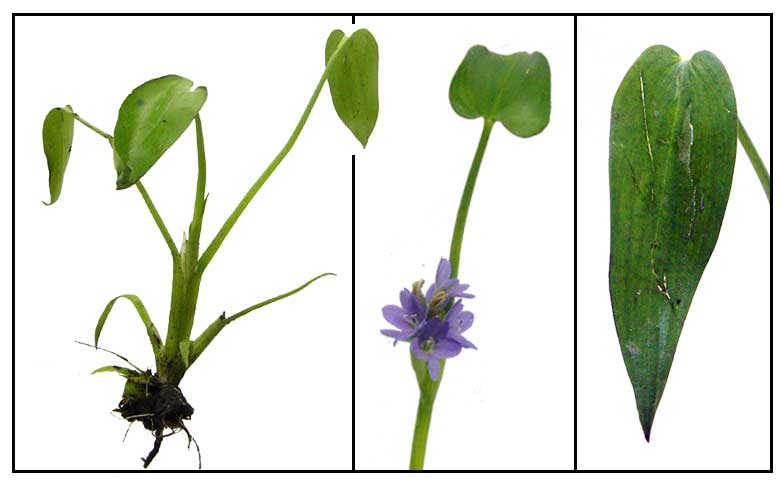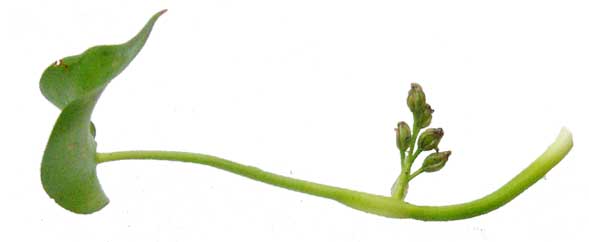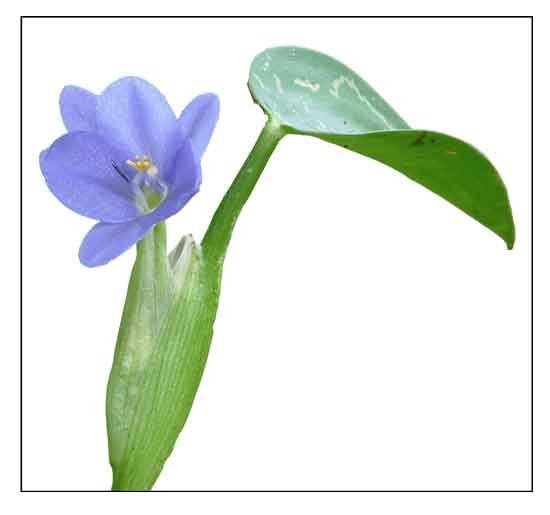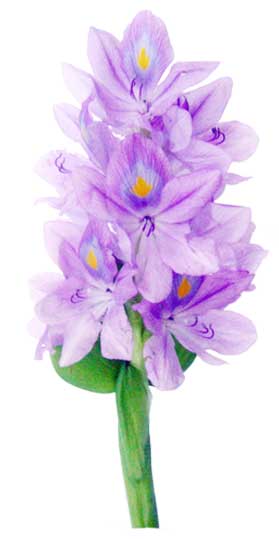 General info General info
- Pontederia is a genus of tristylous aquatic plants, members of the pickerel weeds.
- Pontederia vaginalis is a species of flowering plant in the water hyacinth family.
- Etymology: The genus Pontederia was named by Linnaeus in honor of the Italian botanist Giulio Pontedera. (14) The genus name Monochoria derives from Greek, meaning "single-membrane," referring to the persistent covering of the fruit. The species epithet vaginalis refers to the shealth covering the leaf-like spathes of the inflorescences.
(28)
Botany
• Gabing-uak is an aquatic herb, smaller than gabi-gabihan (Monochoria hastata). Rootstocks are short,
suberect or creeping, and spongy. Leaves are extremely variable, long-petioled, linear to
ovate, oblong-ovate to broadly ovate, with a sharply acuminate apex
and cordate base, and with broad lobes, 6 to 10 centimeters long. Petioles are usually less than 30 centimeters long. Inflorescence is spicate, 3 to 6 centimeters long, and few-flowered. Flowers are blue, about 1 centimeter long, pedicles less
than 1 centimeter long. Capsules are oblong.
• Monochoria vaginalis is a herbaceous plant that usually grows as an annual but may persist for more than a year in permanent water. Extremely variable in height, ranging from 3 to over 50 cm. Erect, and occasionally creeping, the plant may be emergent or floating in freshwater. Stem:Creeping or ascending, rarely forming rhizomes.Foliage: Leaves long, linear or lanceolate to ovate in shape, each with petiole up to 50 cm long. Flowers: Flowers are borne on terminal inflorescences that have 2-50 cm long stalks that become strongly deflexed when flowers develop into fruits. Inflorescence stalks terminate with two opposed modified leaves, known as spathes. The dominant lower spathe is leaf-like, linear or lanceolate to ovate or cordate in shape, with a sheath and may enclose the upper spathe. Flowers are bisexual, showy and blue to white in color, with six stamens (= male reproductive parts of a flower, each consisting of the anther and filament), of which five are yellow, one blue. Flowering takes place in the morning, withering within a day. Fruits: Fruit a capsule that is ellipsoidal to subglobular in shape, that dehisces through the compartments within, containing many seeds. Seeds brown to black in color, cylindrical to ovoid or subglobular in shape, each with 8-14 longitudinal ribs resembling wings. Following the fertilization of the inflorescence, the weight of the developing young fruits pulls the structure downwards such that the development of the fruits takes place in water. Seeds subsequently germinate in water as well, upon liberation from the fruit. (28)

Distribution
- Native to the Philippines.
-
At low and medium altitudes in open wet places, rice paddies, swamps, etc., from Luzon to Mindanao.
- Also native to Afghanistan, Andaman Is., Assam, Bangladesh, Borneo, Cambodia, China North-Central, China South-Central, China Southeast, East Himalaya, Hainan, India, Inner Mongolia, Japan, Jawa, Korea, Laos, Lesser Sunda Is., Malaya, Maluku, Myanmar, Nansei-shoto, Nepal, New Guinea, Northern Territory, Pakistan, Queensland, Sulawesi, Sumatera, Thailand, Vietnam, West Himalaya, Western Australia. (20)
- A serious weed in ricefields in east and southern Asia.
- It is often an invasive noxious weed; listed on the United States Federal Noxious Weed List.
 Constituents Constituents
- Various root extracts yielded alkaloids, carbohydrates, phenols, glycosides, tannins, flavonoids.
-
An ethanol extract yielded phytoconstituents n-hexadecanoic acid, 3-methyl- acetate-1-butanol, 1,1,3-triethoxy- propane, Z,Z,Z- 1,4,6,9 - nonadecate-traene, undecanoic acid, 3-trifluoroacetoxy penta decane and 4-ethyl-5-octyl-2,2-bis (trifluoromethyl) - cis-1,3-dioxalone.
- Study of whole plant isolated three new compounds--two cerebrosides and one acylglycosyl sterol.
- Study for mineral content yielded potassium (9.19 ppm), K/Na ration (7.67)
, Mg (3.028 ppm), Cu (0.138 ppm), Pb (0.021 ppm), Mn (3.386 ppm). (see study below) (19)
- Proximate composition (g/100 g DW) yielded 97.5 ± 0.1 g/100 g FW), carbohydrate 38.5 ± 1.1 g, protein 19.6 g, fat 0.9 ± 0.1 g, fiber 11.3 ± 0.4 g, ash 13.2 ± 0.5 g, energy 240 kcal. Mineral composition (mg/g) yielded sodium 18.8 ± 2.1, potassium 20.2 ± 5.0, magnesium 1.64 ±0.1, calcium 4.4, iron 33.1 ± 0.5 mg/100g, zinc 37.8 ± 1.2 µg/g, copper 67.1 ± 1.0 µg/g.
(25)
- Crude methanolic extract yielded saponin, terpenoid and flavonoid. (see study below) (27)
Properties
- Root stock and leaves are cooling, bitter, sweet, aromatic, alterant, diuretic and tonic.
- Studies have suggested antioxidant, hepatoprotective, cardioprotective, memory enhancing, phytoremediative, anti-inflammatory, nephroprotective, antidiabetic, nutritive, lipoxygenase inhibitory properties.
Parts utilized
Leaves, roots.
Uses
 Edibility Edibility
- Tubers, leaves and aerial parts are
eaten, raw or cooked.
- In Bengal, tender stalk and leaves are eaten as vegetable.
- In Java, entire plant, except for the roots, eaten as vegetable.
-
Nutritional evaluation suggests the plant can be an alternative nutrient rich leafy vegetable.
Folkloric
- Leaves are poulticed after boils have burst.
- Juice of roots for stomach and liver problems, asthma and toothache.
- In Java leaf juice use for coughs; roots for stomach and liver complaints, asthma and toothache. Leaves with ginger and honey taken for cough and cold.
- Bark eaten with sugar for asthma.
- In India, used for burns and scalds; general
debility, asthma, fever, hemorrhage, cough, scurvy, dipsia, strangury, gastropathy, hepatopathy, odontalgia, scurvy and hemorrhages.
- Paste of tuber used externally as antidote to snakebite poisoning in Tamil Nadu.
- In Tripuri, India, decoction of fresh roots used for nausea. Whole plant is cooked by tribal people and used in digestive disorders.
Young shoots used for gastritis and asthma.
- Paniya tribe of India use the leaves for diabetes.
- In the Siddha system, roots is used for cough, disease of pitta, venereal afflictions, thirst, fainting, and fever.
- Juice of leaves applied to boils.
- In Ayurvedic and Unani
medicine, root is chewed for toothaches and sugared bark for asthma.
Studies
• Phytoremediation: Monochoria vaginalis is one of the plants considered promising candidates for cleaning up arsenic-contaminated
surface water and wetland areas. (2)
• Antioxidant / Anti-Inflammatory / Leaves: Root and leaf extracts were evaluated for antioxidant and anti-inflammatory properties. An ethanol leaf extract showed maximum radical scavenging activity in ABTS, superoxide and hydrogen peroxide assays. In in vivo anti-inflammatory study, a methanolic leaf extract showed appreciable reduction in paw volume. (5)
• Nephroprotective / Acetaminophen Induced Toxicity: Study investigated a methanol extract in rats with acetaminophen-induced toxicity. Results showed it can prevent renal damage from APAP-induced nephrotoxicity in rats, probably mediated through active phytoconstituents and antioxidant activities. (6)
• Biochemical and Nutritional Evaluation: Nutritional evaluation showed maximum amount of total carbohydrates, total protein, reducing sugar and amino acids like methionine were present in the young leaf. The plant can be proposed as an alternative nutrient leaf vegetable. (13)
• Hepatoprotective / Carbon Tetrachloride Hepatic Injury: Study investigated a methanolic extract of Monochoria vaginalis for antioxidant and curative effect against CCl4 induced acute liver injury in rats. Extract treatment showed significant protection of liver as evidenced by enzymes and lipid peroxide levels, together with reduction in histopathological changes. Antioxidant status was measured by activity of GSH, catalase, SOD, GST and GPx. Activity was attributed to the presence of flavonoids and alkaloids. (15) Study showed rats pretreated with M. vaginalis and Silymarin remarkably prevented the elevation of AST, ALT, ALP, $ liver peroxides in CCl4 treated rats. (24)
• Analgesic Activity / Roots: Various extracts of roots yielded alkaloids, phenols, carbohydrates, glycosides, tannin, and flavonoids. Total ethanolic extract, chloroform fraction, and aqueous extract of M. vaginalis showed analgesic activity by Tail Immersion and Eddy's hot plate methods. (16) Study evaluated alcoholic and aqueous extract of roots of M. vaginalis in mice. Results showed high analgesic activity in the tail immersion and hot plate tests, with higher degree of analgesic in the alcohol extract compared to the aqueous extract. (26)
• Alkenylphenol and Steroids: Stud isolated two new compounds from the whole plant— (10Z)-1-(2,6-dihydroxyphenyl)octadec-10-en-1-one (1) (20R,24R)-campest-5-ene-3b,4b-diol (2)— together with nine known ones. (17)
• Anti-Diabetic / Leaves: Study of hydroalcoholic extract of leaves for anti-diabetic activity in alloxan induced diabetic albino rats. Results showed significant reduction in blood glucose levels. (18)
• Mineral and Heavy Metal Content: In a study of mineral content and heavy metal content of traditionally important aquatic plants of Tripura, India, Monochoria vaginalis showed: potassium (9.19 ppm), K/Na ration (7.67)
, Mg (3.028 ppm), Cu (0.138 ppm), Pb (0.021 ppm), Mn (3.386 ppm). (19)
• Nutritional Composition / Leaves and Flowers: Study evaluated the nutritional composition of leaves and flowers of M. vaginalis. Almost all essential and nonessential amino acids were present in leaves and flowers. with the nonessential amino acids, especially aspartic acid and glutamic acid, higher in flowers than leaves. The flowers yielded higher amounts of nonessential amino acids, especially aspartic acid and glutamic acid, and higher amounts of proteins (10.8g/100g) and carbohydrates (4.6g/100g). Mineral analysis yielded adequate amounts of phosphorus, potassium , magnesium, copper, manganese and calcium. Study suggests M. vaginalis can be used as a nutritional food supplement. (21)
• Hepatoprotective / Acetaminophen-Induced Hepatotoxicity: Study evaluated an ethanol extract of M. vaginalis on acetaminophen induced rat hepatic injury. Results showed hepatoprotective and antioxidant effects against APAP-induced hepatotoxicity and oxidative stress in rats. The activity of EEMV at 500 mg/kbw was comparable to standard drug silymarin (25 mg/kbw). (22)
• Phytoremediation Potential / Heavy Metal Accumulation: Study evaluated the bioaccumulation potential of six ecotypes of M. vaginalis from six different industrial zones in West Bengal, India, based on chromium (Cr), cadmium (Cd), and copper (Cu) accumulation pattern. Accumulation pattern significantly differed among ecotypes, and accumulation in plant organs was highly metal specific. Cr and Cu predominantly accumulated in leaves and rhizomes while Cd was predominant in roots. Cu showed higher capability in edible parts. Results showed the potential of plant parts as bioaccumulation organs and use for phytoremediation of heavy metal contamination in aquatic ecosystems. (23)
• Lipoxygenase Inhibitory Activity: In a study of various methanol extracts of plants for lipoxygenase inhibitory effects, M. vaginalis exhibited 12.5% inhibition. (27)
• Antioxidant / Phenolic Content / Leaves and Fruits: Study evaluated the antioxidant activities, phenolic and flavonoid contents of leaves and fruits of M. vaginalis leaves and fruits and Cissus repens stems. The ethanol extracts from M. vaginalis leaves showed highest total phenolic content (TPC) and total flavonoid content (TFC) at 336.30 mg GAE/g and 15.41 mg QE/g, respectively. M. vaginalis methanol extract also showed best antioxidant activity with IC50s of 169.93 ppm and 159.76 ppm for DPPH and ABTS scavenging assays respectively. (29)
• Nutritional Assessment / Potential as Supplement to Human Diet / Leaves and Flowers : Monochoria vaginalis is a common weed in Oryza sativa fields. Study evaluated the nutritional composition of leaves and flowers. Almost all essential and nonessential amino acids were present in the leaves and flowers. Nonessential amino acids, especially aspartic acid and glutamic acid, were higher in flowers than leaves. There was more nitrogen in leaves (9.7 mg/100g) compared to flowers (6.3 mg/100g). Phosphorus, potassium, magnesium, copper, manganese, and calcium were found in nutritive levels. Proteins (10.8 g/100g) and carbohydrates (4.6 g/100g) were higher in flowers than leaves. Results suggest potential as nutritional food supplement. (30) (see also: 25)
• Hepatoprotective / Acetaminophen Toxicity in HepG2 Cell Lines / Root: Study evaluated the hepatoprotective efficacy of metabolites in the active fraction from root stocks of Monochoria vaginalis against acetaminophen induced toxicity in HepG2 cell lines. Results showed hepatoprotective activity at concentration of 12.5 µg/ml. Hepatoprotective effect was attributed to combine effect of phytoconstituents like alkaloids, phenolics, and flavonoids. (31)
• Cardioprotective / Doxorubicin Induced Cardiotoxicity / Antioxidant / Leaves: Study evaluated an ethanolic leaf extract of M. vaginalis for invitro antioxidant and cardioprotective activity against DOX-induced cardiotoxicity in rats. The ethanolic extract exhibited strong antioxidant activity by various assays. Pretreatment of DOX treated rats at doses of 250 and 500 mg/kg significantly prevented altered enzymes phopholipase, xanthine oxidase and lipid peroxides were enhanced following depletion of glycogen and phospholipids. (32)
• Memory Enhancing Effect / Kuvalaya / Leaves: Ashtangahrdaya describes a formulation called chathushkuvalaya rasayana, where Kuvalaya, the only herbal ingredient, is identified as Monochoria vaginalis and is glorified as a potent memory enhancer. Study evaluated the memory enhancing effect of Kuvalaya Ghrta (KG), Kuvalaya swarasa (KS), and ethanolic extract of Kuvalaya (KEE) using T-maze test. GIV-KG (Kuvalaya Ghrta 4.32 ml/kg) showed improvement in memory after chronic dosing for 14 days. Post-Hoc analysis revealed GIV-KG provided considerable improvement in memory compared to other groups, which was statistically significant, but did not have significant memory enhancement compared with standard drug (GIII-Pira). No acute toxicity was observed with the extract up to 2000 mg/kg. (33)
Availability
Wild-crafted. |


![]()

